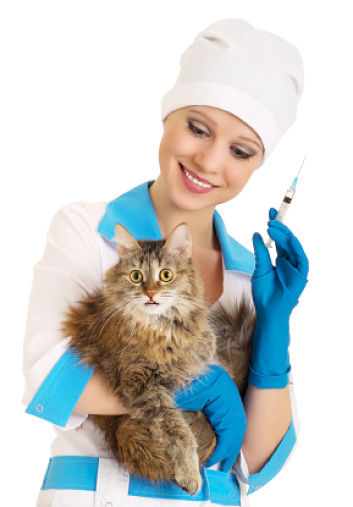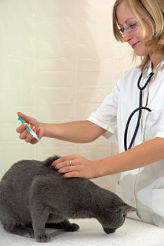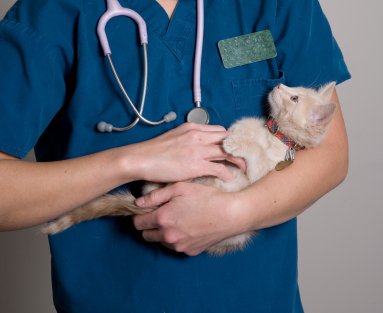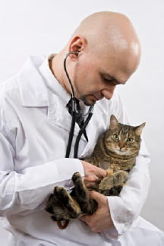Fighting the Feline Leukemia Virus

The feline leukemia virus (also known as FeLV) is a notorious killer of cats. There is no effective cure, and about 80 percent of infected animals die within 3 1/2 years. But, fortunately, the effort to slow the spread of this virus seems to be gaining ground thanks to extensive testing and vaccination.
While FeLV is almost a household word among cat owners today, it wasn't always. Before 1964 no one had heard of such a thing. But in 1964 William Jarrett looked through an electron microscope and noticed particles of an unfamiliar virus clinging to the tumor cells of a cat with feline leukemia (a cancerous proliferation of white blood cells in the bone marrow and blood).
Since Jarrett's discovery, vets have come to realize feline leukemia virus does far more than simply cause feline leukemia. Only a minority of FeLV infected cats actually develop leukemia. More often, cats develop a solid tumor of the white blood cells called a lymphoma.
Feline leukemia virus also attacks blood-generating cells in a cat's bone marrow, so many infected cats end up with shortages of white blood cells, platelets, and red blood cells (anemia). And the virus suppresses the immune system, leaving a cat vulnerable to a whole host of feline diseases. Unfortunately, it's only a matter of time before most FeLV positive cats succumb to one of these opportunistic infections.
Previous studies of feline leukemia virus have found between 2-4 percent of cats nationwide are infected with feline leukemia virus. Because FeLV is spread by cat-to-cat contact, infection rates tend to be higher in multi-cat households and large colonies of cats. But efforts to isolate infected cats, extensive testing programs, and FeLV vaccines seem to be paying off. At least one investigation suggests the number of infected cats is half of what it was in the 1970's.
Also, Feline Leukemia Virus doesn't succeed in conquering every cat it finds. In fact, as many as 70 to 80 percent of exposed adult animals fight off the virus without getting infected. (Kittens under 16 weeks of age are far more vulnerable). If a cat doesn't successfully resist the virus, the animal usually becomes persistently viremic. The outlook is grim in these cases. FeLV invades the animal's lymph nodes, spleen, and eventually its bone marrow.
Occasionally, a cat exposed to FeLV develops a latent infection. Such a cat harbors the virus in its bone marrow but tests negative, shows no signs, and is not contagious. The animal may eventually clear the infection or simply harbor it indefinitely. But if a latently infected cat becomes stressed from disease, pregnancy, or environmental upheaval, the latent virus may well transform into an active form.
The most commonly used test for feline leukemia virus is the enzyme-linked immunosorbent assay called ELISA for short. Your vet can run this test right in the office using a small sample of your cat's blood. Saliva and tears can also be used but blood gives the most reliable results.
The ELISA is very good at detecting FeLV and you can be confident if your cat gets a negative ELISA that he doesn't have the disease. But the ELISA occasionally registers a false positive ...incorrectly indicating that a healthy cat is infected.
So, if your cat appears healthy but comes up positive on a routine ELISA, your vet will probably recommend double-checking the results with a second ELISA or another type of test...the indirect fluorescent antibody (IFA)test. The IFA test must be run in a laboratory, so you'll probably have to wait a week to get the results.
If your pet registers positive on the IFA test, it means FeLV has progressed beyond the lymphoid tissue and invaded the bone marrow. A cat with this degree of infection has very little chance of recovery.
If you have a multi-cat household and you plan to let a stray join your group then I suggest you do what I do. Quarantine the newcomer with food and water in another room and don't let any of your other cats in until you've had a chance to take it to the vet for FeLV testing and a thorough checkup. Even if you don't have other cats...having the test is a good idea. A virus infected cat requires special care, and you should consider its needs before adopting it.
If you are bringing an FeLV -positive cat into your home, or one of your resident cats turns out to be positive, you'll need to take precautions. If possible, establish a separate living and dining area for infected cat. Also, immediately get all the healthy cats in your home vaccinated against FeLV.
While the vaccine is not 100 percent effective, a cat has a better chance of resisting infection if it's vaccinated before exposure to FeLV. You should also get a cat you let outdoors vaccinated to help protect him. If your cats live indoors and don't live with infected animals they don't need the vaccine.
While Feline Leukemia Virus has no cure, infected cats that get lots of tender, loving care may live comfortably for some time. Some of them go on for 5,6,7 years. Owners who have an FeLV infected cat should keep them indoors and away from other cats as much as possible. This helps the infected cat stay isolated from diseases that could overwhelm its weakened immune system, and it prevents outside cats from getting the virus and passing it along.
Almost all FeLV transmission is from cat to cat via bodily fluids such as saliva, blood, urine, feces and milk. The virus most commonly spreads when an infected cat fights, grooms, or shares a food dish with a healthy cat. Also, an FeLV positive queen almost always passes the deadly virus on to her nursing kittens and they have very little resistance to disease and often succumb within a few weeks. Fortunately you have little chance of carrying FeLV from an infected animal to your own cat.
A few years ago a veterinary article stated that the virus is fragile and usually dies within 5 minutes of exposure to outside air...although recently, a paper written by Cornell University College of Veterinary Medicine says it survives less than 2 hours in a dry environment and up to 2 days in a wet environment like litter. Whichever is correct , play it safe and always thoroughly wash and dry your hands after petting an unfamiliar cat.
Related Articles......
Return from Feline Leukemia Virus to Cat Health Homepage
Having trouble finding what you need? Cat Health Index & Site Map
OR
Do you have a question to ask?...Questions
OR
Do you have a cat story to share?...Simply click here to go to that page!
Copyright@2010-2020 All rights reserved.Cat-health-detective.com
This website is information only. Consult a veterinarian for medical assistance

"Like Us" on Facebook
or...
"Like Us" here




















